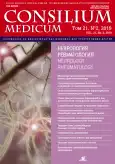Intermittent catheterization of the bladder with tetraplegia due to spinal cord injury
- Authors: Bushkov F.A.1, Salyukov R.V.1,2, Mashaneishvili S.G.2, Romanovskaya E.V.1
-
Affiliations:
- Rehabilitation Center for Persons with Disabilities “Preodolenie”
- People’s Friendship University of Russia
- Issue: Vol 21, No 2 (2019)
- Pages: 64-68
- Section: Articles
- URL: https://journal-vniispk.ru/2075-1753/article/view/96897
- DOI: https://doi.org/10.26442/20751753.2019.2.190219
- ID: 96897
Cite item
Full Text
Abstract
Full Text
##article.viewOnOriginalSite##About the authors
Fedor A. Bushkov
Rehabilitation Center for Persons with Disabilities “Preodolenie”
Email: bushkovfedor@mail.ru
Cand. Sci. (Med.) Moscow, Russia
Roman V. Salyukov
Rehabilitation Center for Persons with Disabilities “Preodolenie”; People’s Friendship University of Russia
Email: salyukov2012@yandex.ru
Cand. Sci. (Med.), Assoc. Prof. Moscow, Russia
Shakro G. Mashaneishvili
People’s Friendship University of RussiaGraduate Student Moscow, Russia
Elena V. Romanovskaya
Rehabilitation Center for Persons with Disabilities “Preodolenie”Senior ergotherapist Moscow, Russia
References
- Cameron A.P, Wallner L.P, Tate D.G et al. Bladder management after spinal cord injury in the United States 1972 to 2005. J Urol 2010; 184: 213-7.
- Powell C.R. Not all neurogenic bladders are the same: a proposal for a new neurogenic bladder classification system. Transl Androl Urol 2016; 5: 12-21.
- Yilmaz B, Akkoç Y, Alaca R et al. Intermittent catheterization in patients with traumatic spinal cord injury: obstacles, worries, level of satisfaction. Spinal Cord 2014; 52 (11): 826-30. doi: 10.1038/sc.2014.134
- Кривобородов Н.С., Ефремов Н.С. Методы опорожнения мочевого пузыря. Рук. для врачей. М.: Е-ното, 2016.
- Harvey L.A, Batty J, Jones R, Crosbie J. Hand function of C6 and C7 tetraplegics 1-16 years following injury. Spinal Cord 2001; 39: 37-43.
- Hashizume C, Fukui J. Improvement of upper limb function with respect to urination techniques in quadriplegia. Paraplegia 1994; 32: 354-7.
- Welk B, Lenherr S, Elliott S et al. The Neurogenic Bladder Symptom Score (NBSS): a secondary assessment of its validity, reliability among people with a spinal cord injury. Spinal Cord 2018; 56 (3): 259 64. doi: 10.1038/s41393-017-0028-0
- Marino R.J, Barros T, Biering-Sorensen F et al, ASIA Neurological Standards Committee 2002. International standards for neurological classification of spinal cord injury. J Spinal Cord Med 2003; 26 (Suppl. 1): S50-56.
- Bolinger R, Engberg S. Barriers, complications, adherence, and self-reported quality of life for people using clean intermittent catheterization. J Wound Ostomy Continence Nurs 2013; 40: 83-9.
- Penders J, Huylenbroeck A.A, Everaert K et al. Urinary infections in patients with spinal cord injury. Spinal Cord 2003; 41: 549-52.
- Sutton G, Shah S, Hill V. Clean Intermittent Self-catheterisation for Quadriplegic Patients-A Five Year Follow-up. Paraplegia 1991; 29: 542-9.
- Yildiz N, Akkoç Y, Erhan B et al. Neurogenic bladder in patients with traumatic spinal cord injury: treatment and follow-up. Spinal Cord 2014; 52 (6): 462-7. doi: 10.1038/sc.2014.41
- Snoek G.J, Ijzerman M.J, Hermens H.J et al. Survey of the needs of patients with spinal cord injury: impact and priority for improvement in hand function in tetraplegics. Spinal Cord 2004; 42 (9): 526-32.
- Салюков Р.В., Колмаков А.С. Нарушения мочеиспускания при шейном уровне позвоночно-спинномозговой травмы. Consilium Medicum. 2016; 18 (2.1): 45-8. [Salukov R.V., Kolmakov A.S. Urinary dysfunction in patients with cervical spinal cord injury. Consilium Medicum. 2016; 18 (2.1): 45-8 (in Russian).]
- Abrams P, Agarwal M, Drake M et al. A proposed guideline for the urological management of patients with spinal cord injury. BJU Int 2008; 101: 989-94.
- Li L. Impact of hydrophilic catheters on urinary tract infections in people with spinal cord injury: systematic review and meta-analysis of randomized controlled trials. Arch Phys Med Rehabil 2013; 94: 782. https://www.ncbi.nlm.nih.gov/pubmed/23168400
- Kiddoo D. Randomized Crossover Trial of Single Use Hydrophilic Coated vs Multiple Use Polyvinylchloride Catheters for Intermittent Catheterization to Determine Incidence of Urinary Infection. J Urol 2015; 194: 174. https://www.ncbi.nlm.nih.gov/pubmed/25584995
Supplementary files






